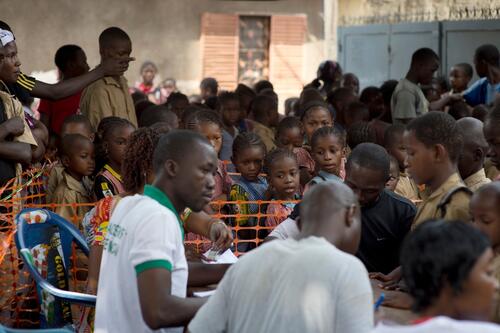Getting vaccinated may seem simple: a nurse, a vaccine, a jab and a lifetime protection. Yet an emergency vaccination is a real logistical challenge, as is the case currently in Guinea, where Médecins Sans Frontières (MSF), supporting the Ministry of Health, has deployed 400 staff. In addition to doctors and nurses, there are logisticians, without whom nothing would be possible.
500,000 children have been vaccinated. Grégoire Putz, one of MSF logisticians describes the challenges faced by MSF teams.
How exactly are MSF teams organised?
MSF teams are organised in pairs: a logistics supervisor and a medical officer. They leave every morning at 6:30 with cold boxes filled with vaccines and thinners, medical kits containing gloves and syringes, and the logistical tools needed for the vaccination sites. On site, they meet up with the teams of vaccinators and advanced personnel made available by the Ministry of Health and recruit people to keep records, give directions and keep order. In the end, each team consists of at least 9 people. But, if there are many children to be vaccinated, more are hired. For example, there may be up to 14 attendants at a single site to manage the crowd. If the route is not marked out and people are not directed, it is very easy to become overwhelmed and even unable to work. On average, 400 people are working daily on this vaccination campaign, but the number varies depending on the day and the needs.
In the evening, the “cold chain” team takes over from 8 pm to midnight. The measles vaccine must be kept cold, and this requires a major logistical effort. All the vaccines have to be taken out, counted and put in the refrigerator, the cold boxes prepared and the icepacks made ready for the next day’s vaccination.
Let’s talk about the cold chain in particular...
This is a crucial step that makes vaccination particularly delicate. If the vaccines are not kept at a precise temperature – between 2 and 8 degrees – they are unusable. This is not easy in a country where the temperature can easily reach 30 to 35° during the daytime and where the electrical supply is highly uncertain!
We have 17 freezers for the refrigerating units and 14 refrigerators to keep the vaccines. When the teams go out to the vaccination sites, the cold boxes serve to maintain the temperature of the vaccine. For this purpose, we have 5,000 frozen icepacks, and when they have to be replaced because they are no longer maintaining a low enough temperature, which happens every 48 to 72 hours, 1,100 of them have to be changed. Since we store several hundred thousand doses of vaccine, we cannot allow the temperature to vary, so we use generators round the clock. In case there are serious problems, we have to ensure backup, because we cannot rely on the Guinean electrical grid. That is system D: a refrigerated container normally used to transport fish that we have also rented!
What is special about this vaccination campaign?
This is an urban vaccination, which makes it very different from other more rural situations, as in the Democratic Republic of Congo. Here, in the cities, we have no problem finding people, but we face other problems related to urban density and a lack of space to set up vaccination sites. We have set them up in various places, such as in an unused factory, a private courtyard or warehouses. There are 10 to 12 million inhabitants in Conakry, and it takes a lot of time to get around. As for exact population figures, there are surprises! In some places, we expect 1,000 people per day and get 1,500. In others, it’s the opposite. We therefore make adjustments as we go to the vaccination planning and to our initial expectations.




